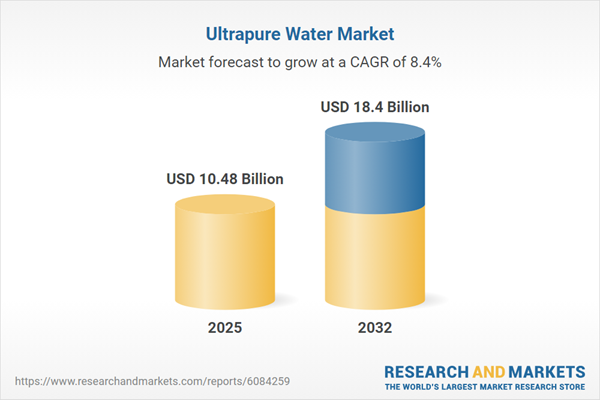Speak directly to the analyst to clarify any post sales queries you may have.
Senior decision-makers seeking to align infrastructure with tightening regulatory standards and sustainability objectives will find the ultrapure water market at a pivotal crossroads. As industries demand ever-greater water purity, the sector is shaped by rapid technology innovation, shifting procurement strategies, and evolving regional requirements.
Market Snapshot: Ultrapure Water Market
The Ultrapure Water Market grew from USD 9.65 billion in 2024 to USD 10.48 billion in 2025. It is expected to continue growing at a CAGR of 8.39%, reaching USD 18.40 billion by 2032.
Scope & Segmentation
- End Use Industries: Cosmetics, Healthcare, Laboratories, Pharmaceutical Manufacturing (including Biopharmaceuticals and Generic Drugs), Power Generation, Semiconductor Manufacturing (encompassing Back End and Front End)
- System Types: Recirculation Systems (featuring Continuous Electrodeionization, Ultrafiltration, and Ultraviolet Oxidation), Single Pass Systems (inclusive of Ion Exchange and Reverse Osmosis)
- Purity Grades: Type I (Resistivity 18.2, TOC Below 10), Type II, Type III
- Applications: Analytical Testing, Boiler Feed, Cleaning (Batch Cleaning, In-Line Cleaning), Formulation, Rinsing
- Regions Covered: Americas (North America, Latin America), Europe, Middle East & Africa, Asia-Pacific
- Key Players Assessed: Veolia Water Technologies & Solutions SA, SUEZ Water Technologies & Solutions SAS, Ecolab Inc, Evoqua Water Technologies LLC, Kurita Water Industries Ltd, Aquatech International LLC, The Dow Chemical Company, Graver Technologies Inc, 3M Company, Parker-Hannifin Corporation
Key Takeaways for Senior Decision-Makers
- Mission-critical industries require ultrapure water to protect product quality, process reliability, and compliance with evolving regulatory expectations.
- Technological advances, such as continuous purification and real-time analytics, enable a shift from reactive troubleshooting to proactive contamination prevention.
- Sustainability goals are driving scrutiny over water reuse, energy efficiency, and chemical consumption throughout ultrapure water operations.
- Procurement teams are responding to supply chain complexity by diversifying vendors, negotiating long-term agreements, and increasing focus on lifecycle support and traceability.
- Regional dynamics shape deployment strategies: mature service ecosystems in the Americas, flexible compliance support in Europe and the Middle East & Africa, and rapid capacity expansion in Asia-Pacific require tailored execution plans.
- Vendor differentiation hinges on integrated hardware, digital monitoring, validation support, and robust spare parts networks to ensure continuous system performance.
Tariff Impact on Procurement and Supply Chain Strategies
Recent tariff implementations affecting critical components and treatment equipment have added new layers of complexity to the procurement of ultrapure water systems. Organizations are evaluating total cost of ownership, prioritizing contractual clarity, and developing contingency measures such as alternate supplier qualification and modular design. These responses mitigate risks associated with extended lead times and cost fluctuations, ensuring long-term operational continuity.
Methodology & Data Sources
This report employs a mixed-methods approach combining in-depth interviews with market practitioners, review of technical literature, and iterative expert validation. Data triangulation ensures robust findings that reflect the realities of facility management, quality assurance, procurement, and operations within the ultrapure water landscape.
Ultrapure Water Market: Why This Report Matters
- Enables executives to benchmark procurement, operational, and compliance strategies against industry best practices and peer experiences.
- Supports investment decisions on technology upgrades, supplier networks, and workforce development tailored to segment-specific purity and reliability needs.
- Delivers strategic guidance to enhance resilience, streamline regulatory compliance, and drive sustainability within ultrapure water operations.
Conclusion
This research provides a comprehensive, actionable view of the ultrapure water market. Senior leaders can use these insights to future-proof water systems, optimize investments, and enhance reliability across global facilities.
Table of Contents
3. Executive Summary
4. Market Overview
7. Cumulative Impact of Artificial Intelligence 2025
Companies Mentioned
The companies profiled in this Ultrapure Water market report include:- Veolia Water Technologies & Solutions SA
- SUEZ Water Technologies & Solutions SAS
- Ecolab Inc
- Evoqua Water Technologies LLC
- Kurita Water Industries Ltd
- Aquatech International LLC
- The Dow Chemical Company
- Graver Technologies Inc
- 3M Company
- Parker-Hannifin Corporation
Table Information
| Report Attribute | Details |
|---|---|
| No. of Pages | 194 |
| Published | October 2025 |
| Forecast Period | 2025 - 2032 |
| Estimated Market Value ( USD | $ 10.48 Billion |
| Forecasted Market Value ( USD | $ 18.4 Billion |
| Compound Annual Growth Rate | 8.3% |
| Regions Covered | Global |
| No. of Companies Mentioned | 11 |







